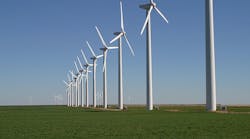A new report released by the Energy Department’s National Renewable Energy Laboratory (NREL) examines the potential impacts of increasing wind and solar power generation on the operators of coal and gas plants in the West. To accommodate higher amounts of wind and solar power on the electric grid, utilities must ramp down and ramp up or stop and start conventional generators more frequently to provide reliable power for their customers – a practice called cycling.
Grid operators typically cycle power plants to accommodate fluctuations in electricity demand and abrupt outages at conventional power plants. They use similar processes to compensate for variable wind and solar generation. The study finds that increased cycling to accommodate high levels of wind and solar generation increases operating costs by 2%–5% for the average fossil-fueled plant.
To calculate wear-and-tear costs and emissions impacts for the new study, NREL designed five hypothetical scenarios to examine generating up to 33% wind and solar energy on the U.S. portion of the Western Interconnection power system for the year 2020. The study models cycling impacts representing a range of wind and solar concentrations between 0% and 33% and does not endorse any particular level.
In the high wind and solar scenarios, in which one-fourth of the energy in the entire western grid, including portions of Canada and Mexico, would come from these sources, the carbon footprint of the western grid was reduced by about one-third. The study also finds that the carbon emissions induced by more frequent cycling are negligible (<0.2%) compared with the carbon reductions achieved through the wind and solar power generation evaluated in the study. The sulfur dioxide emissions reductions made possible if wind and solar would provide 33% of the power on the grid are 5% less than they would be if cycling of fossil-fueled generators wasn’t necessary. In the high wind and solar scenarios, cycling results in 2% more emissions reductions of nitrogen oxides from fossil-fueled generators than expected if cycling these plants wasn’t needed. This is because the average coal plant in the West has a lower nitrogen oxide emissions rate at partial output than at full output.
The study also finds that high levels of wind and solar power would reduce fossil fuel costs by approximately $7 billion per year across the West, while incurring cycling costs of $35 million to $157 million per year. For the average fossil-fueled plant, this results in an increase in operations and maintenance costs of $0.00047 to $0.00128 per kilowatt-hour of generation.
WWSIS-2 does not consider other factors such as capital costs of construction for wind, solar, fossil-fueled power plants, or transmission. These costs are significant, but outside the scope of this study, which focuses on operations.
The final report is available on the Energy Department’s Wind Program website. Additional resources can be found on NREL’s Western Wind and Solar Integration Study website.
This study is a joint effort between the Office of Energy Efficiency and Renewable Energy and the Office of Electricity Delivery and Energy Reliability. Learn more about the Energy Department's efforts to research, develop, deploy, and integrate innovative wind and solar energy technologies on the Wind Program and SunShot Initiative websites.



